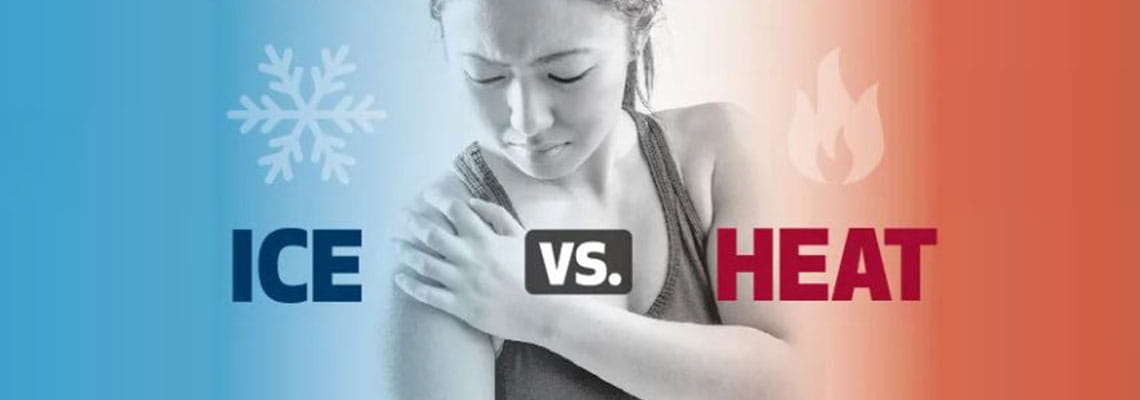Ice Vs. Heat: When to Use Which for Aches & Pain

It's Day 3 of your knee pain and it's finally time to do something about it. Your plan to get some relief looks similar to anyone's:
- A pain reliever
- A chair to prop your leg up on
- Can't forget the ice...
- Or should you use heat instead?
You grew up hearing R.I.C.E (rest, ice, compression, elevation), so ice must be the answer, right? But, on the other hand, sometimes soaking in a hot tub makes you feel like you can actually relax the pain away. So, when it comes to relieving muscle pain, which is better: ice or heat? Fortunately, Dr. Kenneth Brooks, orthopedic surgeon specializing in knee surgery at Houston Methodist, is here to set the record straight. "Both ice and heat can help play important roles in relieving muscle or joint pain, but each works on your body in a different way," explains Dr. Brooks. "This means that it matters when and how you apply ice or heat."
Coolin' Down
How ice can help relieve pain
We all know that ice is great at numbing pain. Stubbed your toe? Grab an ice pack. Crushed your finger? Grab an ice pack. Banged your head. You guessed it: Ice pack!
But, according to Dr. Brooks, ice is more than just an analgesic. In fact, ice is particularly helpful if your muscle or joint pain is associated with the swelling that typically accompanies an exercise-related overuse injury or arthritis. "Applying ice causes your blood vessels to narrow, decreasing blood flow to the area. In turn, this helps reduce the inflammation that causes swelling," says Dr. Brooks. "Even if you can't actually see the swelling, one of its symptoms is pain.
This means that if you can reduce your swelling, you can reduce your pain." The most common way to use ice to help relieve muscle or joint pain is to apply an ice pack to the area for about 20 to 30 minutes. It's important to stick to this time frame, since over-icing can lead to skin damage. (Think: freezer burn.)
Heatin' Up
How heat can help relieve pain
We know that when it comes to temperature and how each makes our skin feel, heat and ice couldn't be more opposite — one warms you up, the other cools you down. And this difference extends to what's happening under your skin, too.
"Applying heat causes your blood vessels to expand, increasing blood flow," explains Dr. Brooks. "This brings more biological products, such as oxygen and nutrients, to the injured area, which can help relieve the source of your pain over time."
As a result, heat has a number of potential and perceived benefits, such as:
- Decreasing joint stiffness
- Increasing flexibility
- Reducing pain
- Alleviating muscle cramps and spasms
"Similar to ice, heat should only be applied for a limited amount of time. If you're applying heat via a heating pad, the appropriate amount of time is between 20 and 30 minutes," recommends Dr. Brooks.
Hot vs. cold
So, is ice or heat better for pain?
So...ice can help relieve pain, heat can help relieve pain, and ice and heat work in completely different ways — so, in the debate of ice vs. heat, which reigns supreme? When it comes to relieving pain, Dr. Brooks says the answer depends on the type of pain you're experiencing and what you're currently doing. "For muscle or joint pain caused by exercise-induced tissue damage (from overuse) or arthritis, there's a role for both ice and heat — and knowing when to use which is as easy as following advice you're already used to: Warm up before activity, and cool down afterward," explains Dr. Brooks. "Before exercise or activity, use heat to reduce joint stiffness and improve joint flexibility. After activity, use ice to reduce post-exercise discomfort." Heat and ice also have a place in between activity and exercise. "Since heat can help speed up the process of repairing damaged tissue and ice can help reduce the painful swelling you may be experiencing, I recommend rotating between heat and ice throughout the day as you recover from an exercise-related overuse injury," explains Dr. Brooks.
And if your pain isn't from exercise, but rather the result of tension in your muscles from sitting at a computer all day, Dr. Brooks recommends skipping the ice altogether and opting for the relaxation benefits that heat can have on tight muscles. Whatever you do, just be sure to avoid using ice immediately prior to exercising — as this has been shown to negatively impact muscle strength and function, which can lead to reduced performance and potentially an increased risk of injury. In addition, heat and ice shouldn't be the only components of your warmup and cool-down routine. Be sure to pair heat with light warmup exercises and ice with a post-exercise stretching period.
Know when it's time to see a doctor about your joint pain
While ice and heat can help manage the muscle soreness that comes with exercise and other minor issues, pain can also be a sign that it's time to see a doctor.
Here are five signs that joint pain warrants evaluation:
- The pain is very unpleasant and begins after a specific movement or while exercising.
- Swelling or bruising is accompanying the pain.
- Your range of motion is significantly limited or you're unable to complete daily functional activities.
- The pain lingers beyond three days.
- The pain keeps coming back.
March 9, 2023
